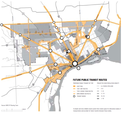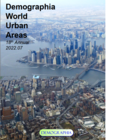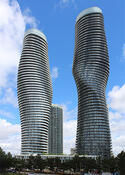Without a great deal of thought put into it, most urban observers can rattle off what can be considered a reasonable life cycle for neighborhoods – a growth phase, a stable peak or plateau, a period of decline, a phase of accelerated decline, then ultimately a chance at renewal. read more »
Urban Issues
Life Cycle of Black Urban Neighborhoods
- Login to post comments
Demographia World Urban Areas: 2022 Released
The 2022 edition of Demographia World Urban Areas has been released, which provides revised population estimates based on the 2020 round of censuses, though some censuses have been delayed due to the pandemic (such as in India and Bangladesh). read more »
Fair Park First Might Prompt 21st Century Urban Renewal, Wiping Out Neighborhoods
Recently, exciting plans for Fair Park were unveiled at an architectural forum by Fair Park First, the nonprofit selected to transform and manage Fair Park’s transformation. read more »
- Login to post comments
Learning From Las Vegas: Sustainable vs. Susceptible
I hear a great deal about sustainability in the built environment that sounds both encouraging and delusional. These messages come from well intentioned environmentalists as well as corporate marketing departments. The general tone of the conversation is similar either way. Everyone can continue to live the way we do now, but by making a few minor adjustments we’ll transition away from coal, oil, and natural gas to benign materials and clean renewable energy. This transition will save households money, preserve nature, and be profitable for private enterprise. read more »
- Login to post comments
May Transit 59.5% of Pre-Pandemic Levels
Transit ridership remained below 60 percent of pre-pandemic levels in May 2022, according to data released by the Federal Transit Administration recently. This was only a slight improvement over April’s 58.7 percent despite average fuel prices climbing from a little over $4 in April to more than $4.50 in May. read more »
Densification in Toronto: The Evolving Urban Form
Like many of the world’s largest cities (Note 1), public policy seeks to densify Toronto, which is already the densest urban area (the international term) or population centre (the Canadian term) in North America (as used here, north of Mexico). An urban area is continuously built up urbanization and is routinely at the core of a metropolitan area (in Canada, a Census Metropolitan Area, or CMA). read more »
- Login to post comments
Deteriorating Housing Affordability in Canada
The Frontier Centre for Public Policy has released the 2022 edition of Demographia Housing Affordability in Canada. read more »
- Login to post comments
Why Many Poor Neighborhoods Fear Development
I remember being very surprised the first time I read about activists in poor communities opposing investment in their parks. I had always thought of such activists as lobbying for public investment into their communities. read more »
- Login to post comments
The Bureaucratization of American Leadership
In newsletter #63 I discussed the managerial revolution, or the way that we transitioned from an entrepreneurial capitalist system dominated by owners to a bureaucratic system dominated by managers and technocrats spanning the public and private sectors. read more »
- Login to post comments
Korea: Moving to the Suburbs of Seoul
The Seoul metropolitan area (also called the Seoul Capital Area) has continued its strong population growth over the past decade, with the 2020 census indicating an annual increase of 1.0%. read more »






















